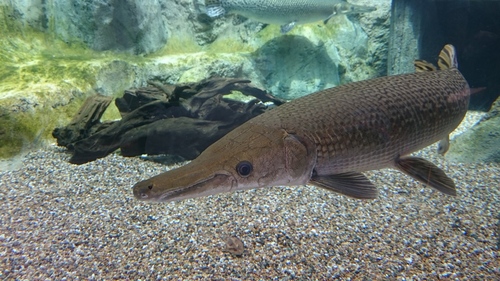
Alligator Gar
The Atlantic bluefin tuna (Thunnus thynnus) is a majestic and highly migratory species renowned for its size, speed, and commercial value. It plays a critical role in the marine ecosystem and has been a prized catch for centuries. However, this magnificent fish faces significant threats.
26 75 years
Lifespan
250 - 300 cm
Length
Least Concern
Conservation Status
15 km/h
Swimming speed
Carnivorous
Diet
Local Migration
Migration
Appearance Overview
The Atlantic bluefin tuna is a large, streamlined fish with a metallic blue body and a silvery underside.
Coloration
Dark metallic blue on top, silvery underside
Body Shape
Torpedo-shaped, built for speed and endurance
Fins
Two dorsal fins, the first is depressible; small finlets run down the back and belly to the tail
Length
Up to 13 feet (4 meters)
Weight
Up to 2,000 lbs (907 kg)
Diet
Carnivorous, feeding on smaller fish (like herring, mackerel, and hake), squid, and crustaceans.
Feeding Behavior
Highly active predator, using speed and agility to hunt; often hunts cooperatively, herding and trapping prey.
Social Behavior
Forms large schools, especially during migration and spawning; schools can be segregated by size.
Commercial Relevance
Extremely high value, especially in sushi and sashimi markets; one of the most expensive fish in the world.
Conservation measures
Subject to strict international fishing quotas and management plans; marine protected areas and fishing gear restrictions are also in place.
Status
Endangered (IUCN)
Threats
Overfishing (historically and ongoing in some areas), illegal and unreported fishing, bycatch in other fisheries.
Habitat Distribution
Depth Range
0-1,000 meters (0-3,280 feet), though typically found in the upper layers of the ocean.
Geographic Range
Atlantic Ocean, Mediterranean Sea, and formerly the Black Sea.
Preferred Environment
Temperate and subtropical waters; pelagic (open ocean) and coastal environments.
Reproduction and Life Cycle
Breeding Habits
Spawns in warm waters, primarily in the Mediterranean Sea and the Gulf of Mexico; spawning occurs in large aggregations.
Development Stages
Eggs hatch into larvae, which are planktonic; juveniles grow rapidly, feeding on small organisms and eventually transitioning to larger prey.
Fecundity
Females can produce up to 30 million eggs per season, releasing them into the water for external fertilization.
Maturity Age
Matures at 4-8 years, depending on the population and environmental conditions.
Faqs about Alligator Gar
How long do Atlantic bluefin tuna live?
Atlantic bluefin tuna can live up to 40 years, though the average lifespan is often shorter due to fishing pressure.
How fast can Atlantic bluefin tuna swim?
They are among the fastest fish in the ocean, capable of bursts of speed up to 40-60 mph.
Are Atlantic bluefin tuna warm-blooded?
Yes, they are warm-blooded, which allows them to maintain a higher body temperature than the surrounding water, aiding in muscle efficiency and speed.
Where do Atlantic Bluefin Tuna spawn?
They primarily spawn in the Mediterranean Sea and the Gulf of Mexico.
How many eggs a female bluefin tuna can release?
A female bluefin tuna can release up to 30 million eggs per spawning season.
When bluefin tuna reach sexual maturity?
Bluefin tuna reach sexual maturity between 4 and 8 years of age.
Do Atlantic bluefin tuna migrate?
Atlantic bluefin tuna undertake long migrations across the Atlantic Ocean, often traveling thousands of miles between feeding and spawning grounds.
Copyright @ Nature Style Limited. All Rights Reserved.
 English
English